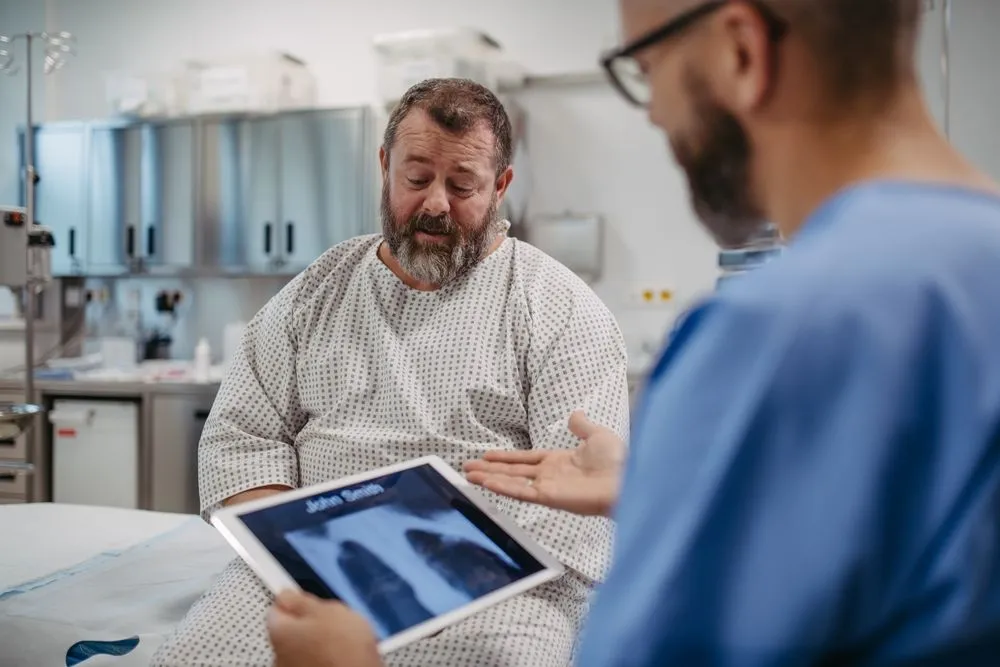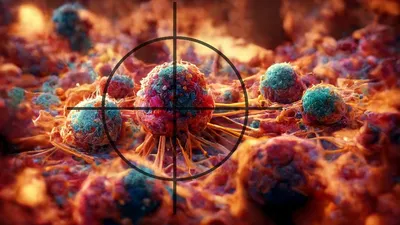How Can Large B-Cell Lymphoma Affect the Lungs?

Diffuse large B-cell lymphoma (DLBCL) is an aggressive, B-cell non-Hodgkin lymphoma (NHL) that primarily affects the lymph nodes, although it can affect other parts of the body, including the lungs. There are two main ways in which DLBCL can affect the lungs:
- Primary pulmonary DLBCL
- Secondary pulmonary DLBCL
What is Primary Pulmonary Lymphoma?
Primary pulmonary lymphoma is a rare type of lymphoma that begins in the lungs. In patients with primary pulmonary lymphoma, cancer cells are found only in the lungs and not in any other parts of the body for at least 3 months after the initial diagnosis.
Primary pulmonary lymphomas are rare, accounting for 0.5–1% of all primary lung cancers. It is the second most common form of primary pulmonary lymphoma, representing 11–19% of all cases. It is more common in older patients and patients with a weakened immune system.
The exact way in which primary pulmonary DLBCL begins is not fully understood. Some cases begin as primary pulmonary DLBCL, but it more commonly occurs as a transformation from primary pulmonary marginal zone B-cell lymphoma of mucosa-associated lymphoid tissue or MALT.
Clinical trials in primary pulmonary DLBCL would help identify the best treatment strategy, but due to its rarity, it is challenging to find sufficient patients. Treatment options may include watchful waiting, surgery, chemotherapy, or chemotherapy followed by radiotherapy.
What is Secondary Pulmonary Lymphoma?
Secondary pulmonary lymphoma is more common than primary pulmonary lymphoma and occurs when lymphoma that begins in other parts of the body spreads to the lungs. Around 24% of non-Hodgkin lymphomas secondarily affect part of the lungs. DLBCL is the most common subtype of secondary pulmonary lymphoma.
How is Pulmonary DLBCL Diagnosed?
Pulmonary DLBCL can be difficult to diagnose due to the non-specific features, which can lead to a misdiagnosis or delayed diagnosis. A CT scan may show signs that the disease is affecting the lungs, such as:
- Masses – tumors within the lungs which can be small or large
- Nodules – small clumps of cells in the lungs
- Consolidation – part of the lungs have become filled with liquid
- Ground glass opacities – hazy grey areas indicating that something is partially filling the area inside the lung
- Lymphangitis/perilymphatic nodules – inflammation of the lymphatic system in the lungs
- Pleural effusion – a build-up of fluid between the layers of tissue that line the lungs and chest cavity
As these signs are not unique to pulmonary DLBCL, a biopsy (a lung sample) may be necessary to confirm a diagnosis.
What are the Symptoms of Pulmonary Lymphoma?
The symptoms of pulmonary DLBCL are non-specific and can be difficult to distinguish from other diseases. This is why it's important to remember that if you experience any new symptom, it's always a good idea to report it to your doctor, who can rule out any lymphoma complications. Symptoms may include:
- Cough
- Shortness of breath
- Coughing up blood
- Chest pain
- Fever
- Excessive sweating
- Weight loss
Connect with Top Lymphoma Specialists Near You
When it comes to lymphoma, having a specialist who truly understands the nuances and potential complications of the disease can make all the difference. From identifying early warning signs to navigating treatment options, a knowledgeable specialist can provide invaluable support. Explore HealthTree's lymphoma specialist directory to find one close to you:
Key Takeaways
- Diffuse Large B-cell Lymphoma (DLBCL) can begin in (primary) or spread to (secondary) the lungs
- Secondary pulmonary DLBCL is more common, although overall, it's a rare complication
- The signs and symptoms are shared with other diseases, which can delay or make the diagnosis difficult
- Report any new symptoms you experience to your lymphoma doctor
Sources:
Diffuse large B-cell lymphoma (DLBCL) is an aggressive, B-cell non-Hodgkin lymphoma (NHL) that primarily affects the lymph nodes, although it can affect other parts of the body, including the lungs. There are two main ways in which DLBCL can affect the lungs:
- Primary pulmonary DLBCL
- Secondary pulmonary DLBCL
What is Primary Pulmonary Lymphoma?
Primary pulmonary lymphoma is a rare type of lymphoma that begins in the lungs. In patients with primary pulmonary lymphoma, cancer cells are found only in the lungs and not in any other parts of the body for at least 3 months after the initial diagnosis.
Primary pulmonary lymphomas are rare, accounting for 0.5–1% of all primary lung cancers. It is the second most common form of primary pulmonary lymphoma, representing 11–19% of all cases. It is more common in older patients and patients with a weakened immune system.
The exact way in which primary pulmonary DLBCL begins is not fully understood. Some cases begin as primary pulmonary DLBCL, but it more commonly occurs as a transformation from primary pulmonary marginal zone B-cell lymphoma of mucosa-associated lymphoid tissue or MALT.
Clinical trials in primary pulmonary DLBCL would help identify the best treatment strategy, but due to its rarity, it is challenging to find sufficient patients. Treatment options may include watchful waiting, surgery, chemotherapy, or chemotherapy followed by radiotherapy.
What is Secondary Pulmonary Lymphoma?
Secondary pulmonary lymphoma is more common than primary pulmonary lymphoma and occurs when lymphoma that begins in other parts of the body spreads to the lungs. Around 24% of non-Hodgkin lymphomas secondarily affect part of the lungs. DLBCL is the most common subtype of secondary pulmonary lymphoma.
How is Pulmonary DLBCL Diagnosed?
Pulmonary DLBCL can be difficult to diagnose due to the non-specific features, which can lead to a misdiagnosis or delayed diagnosis. A CT scan may show signs that the disease is affecting the lungs, such as:
- Masses – tumors within the lungs which can be small or large
- Nodules – small clumps of cells in the lungs
- Consolidation – part of the lungs have become filled with liquid
- Ground glass opacities – hazy grey areas indicating that something is partially filling the area inside the lung
- Lymphangitis/perilymphatic nodules – inflammation of the lymphatic system in the lungs
- Pleural effusion – a build-up of fluid between the layers of tissue that line the lungs and chest cavity
As these signs are not unique to pulmonary DLBCL, a biopsy (a lung sample) may be necessary to confirm a diagnosis.
What are the Symptoms of Pulmonary Lymphoma?
The symptoms of pulmonary DLBCL are non-specific and can be difficult to distinguish from other diseases. This is why it's important to remember that if you experience any new symptom, it's always a good idea to report it to your doctor, who can rule out any lymphoma complications. Symptoms may include:
- Cough
- Shortness of breath
- Coughing up blood
- Chest pain
- Fever
- Excessive sweating
- Weight loss
Connect with Top Lymphoma Specialists Near You
When it comes to lymphoma, having a specialist who truly understands the nuances and potential complications of the disease can make all the difference. From identifying early warning signs to navigating treatment options, a knowledgeable specialist can provide invaluable support. Explore HealthTree's lymphoma specialist directory to find one close to you:
Key Takeaways
- Diffuse Large B-cell Lymphoma (DLBCL) can begin in (primary) or spread to (secondary) the lungs
- Secondary pulmonary DLBCL is more common, although overall, it's a rare complication
- The signs and symptoms are shared with other diseases, which can delay or make the diagnosis difficult
- Report any new symptoms you experience to your lymphoma doctor
Sources:

about the author
Dylan Barrett
Dylan is a freelance medical writer based in Cork, Ireland. He previously worked in independent medical education while living in London and is now collaborating with HealthTree to develop resources for blood cancer patients. His background is in genetics, and he has a passion for innovative scientific research. In his spare time, he enjoys sports, traveling, and spending time with his family and friends.
More on Core Education
Trending Articles
Get the Latest Large B Cell Lymphoma Updates, Delivered to You.
By subscribing to the HealthTree newsletter, you'll receive the latest research, treatment updates, and expert insights to help you navigate your health.
Together we care.
Together we cure.
3x Faster.









